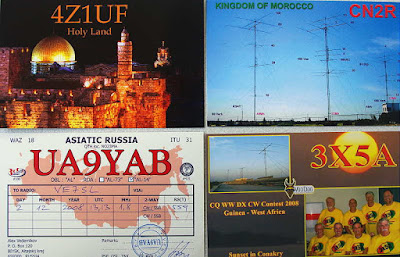Posts Tagged ‘Propagation’
 Upcoming Solar Years … Can They Be Too Quiet?
Upcoming Solar Years … Can They Be Too Quiet?

Most of us LF/MF and topband diehards have been looking forward to the next several years of low solar activity ... maybe even 'ultra-low' as some of the solar gurus are predicting.
An interesting posting on the Topband reflector a few weeks ago by noted propagation expert, Carl, K9LA, made me re-think my expectations!
I flagged the post for a later blog topic but have since seen the information pop-up on a couple of other reflectors as well as on the ARRL News page. Apparently I wasn't the only one to give the posting a double-take. If you missed it, here is Carl's post:
About a week ago Wolf DF2PY posted a message here commenting on the recent adverse levels of geomagnetic field activity and how it will now change for the good - giving us good 160m propagation.
We'll certainly see less geomagnetic field activity as we move into winter,
but there's another issue we should be aware of. The Sun's magnetic field
is weakening - probably to the lowest levels in our lifetime. With a weak
solar magnetic field, more galactic cosmic rays will be able to get into
the Earth's atmosphere. We are now seeing unprecedented high neutron counts (neutrons are one of the by-products of cosmic rays)
Since galactic cosmic rays are mostly *very energetic* protons, they can
get down to low atmospheric altitudes, causing collisional ionization in
the D region (and lower E region). A cursory estimate using cosmic ray
ionization rates confirms more ionization in the lower atmosphere. 160m is
not very tolerant of more absorption, so we may see an adverse effect of
the weakened solar magnetic field.
Many of us think that "solar min is solar min is solar min". But maybe a
solar minimum can be too deep for 160m. A good question to ask in the early 2020s will be "how was 160m?" So stay active on 160m and let's see what happens.
Carl K9LA
My initial response was to think that perhaps there wouldn't be as much to look forward to as I had been hoping for, when it came to improved LF, MF and 160m propagation. Carl's postulation was also backed-up by another mention on the Spaceweather site, although the influence of cosmic ray bombardment on radio propagation was not discussed.
As I thought more about this unfortunate possibility actually coming to pass, I thought back to my own on-air and listening experiences during previous solar-low years ... particularly the unprecedented low between our most recent cycle and its predecessor, Cycle 23.
The low period between these two cycles, as most will likely recall, saw the quietest solar conditions observed in the past 100 years. The solar-low winters saw week after week of a blank Sun, with solar activity virtually flatlining for the entire period. In 2008 there were 265 'zero sunspot' days and the following year saw another 262 days of blank suns!
These effects were well noted here for two winters that are usually prime 'DX times' ... if ever there were a period when cosmic ray bombardment should negatively impact low frequency propagation, surely it would have been then.
So just what did I observe?
What I saw was not only what I had been expecting but was much much better than I had ever believed possible. For west coast topband operators, the 'holy grail' of propagation is working Europe. Working Europe from here means that signals must travel through the polar regions, usually the kiss-of- death for weak signals, as the severe attenuation through the auroral zone means that it just doesn't happen very often ... except for this prolonged period of ultra lows. In a word, conditions to Europe were 'spectacular' ... night-after-night, for several weeks over a period of two winters, working Europe on 160 became normal.
On most nights, European signals could be heard before local sunset, and on several occasions, CW contacts with Europeans, were completed up to one and a half hours before my local sunset. As darkness set in, more signals would appear and the band would rapidly become populated with Europeans ... and only Europeans.
Most of the time there were no signals from North America evident, just Europeans ... a condition that had me shaking my head in disbelief night after night. It was something I had never observed before, as I watched 160m behaving more like 20m CW on a good day to Europe! During this period, my DXCC totals skyrocketed from 99 to 143 worked, as new Europeans and Africans were added to my logbook.
Signal levels were also outstanding, often pushing the FT-1000 S-meter well past the S9 level. On one particular night, I recall hearing an SM4 calling CQ, with just such a signal. I set my output power level at 10 watts and gave him a call, to which he quickly responded. If cosmic ray bombardment was at a high level, it was not reeking any havoc as far as the west coast path to Europe was concerned! For the record, my topband system is nothing special, consisting of a simple 'half-sloper' over a poor ground and a very old amplifier running about 500W output.
My other favorite winter pastime is chasing NDBs in the MF range between 200-500 kHz. Exceptional east west conditions were evident throughout the two winters of ultra-lows.
On one such night, I noted a new strong signal where none had been previously heard. Because of its strength, I surmised that it was probably a new NDB in nearby Washington state. Noting its ident ('NYA' on 414 kHz), I was not able to find any reference to such a beacon being previously reported and turned to the Yahoo ndblist group for help, posting my catch as 'unidentified'. Almost immediately I received a response, telling me that the signal I was hearing was located in Europe ... Svalbard to be exact, located midway between Norway and the North Pole!
Now, European NDBs have never been heard from the west coast, other than occasional signals from some of Greenland's powerhouses, so this represents a very rare event. Although I have often listened for this signal, it has yet to be heard here again and my logging of remains its only reported foray into any part of North America. Unfortunately, in 2015, it was listed as 'decomissioned'. I have no doubts that this rare propagation was a result of the solar flatlining conditions of the time.
As chilling as Carl's warning sounds, he himself admits uncertainty with a 'let's wait and see' attitude and after reviewing my own experiences under what surely must be similar conditions, I'm still very optimistic over what might be in store. Hopefully we shouldn't have to wait too much longer to find out!
 Wishing Upon A Star
Wishing Upon A Star

My love for radio began at an early age when I first started to tune the shortwave bands at age eleven. Little did I know then, that I was listening near the peak of the strongest solar cycle in recorded history, monster Cycle 19.
I thought that what I was hearing was normal for shortwave and that it would always be this way ... and it was, for a number of years.
As the solar cycle slowly declined, I began to take a deeper interest in propagation and its relationship with the Sun. After obtaining my licence and getting on the air, the reality set in with the arrival of a rather dismal Cycle 20. Following the vagaries of propagation became almost a hobby in itself, trying to correlate what I was observing with what the Sun was doing and even getting comfortable with predicting what might happen next.
It was particularly exciting during the stronger Cycles (21-23), to watch the dramatic effect of solar radiation on the F layer during the peak winter years of these cycles. With a major interest in 50MHz, watching the solar flux became a daily ritual, along with the fascinating daily rise of the F2 MUF as the Sun peaked over the horizon.
On normal mornings, around sunrise, the MUF would typically start close to 28MHz and slowly begin to rise over the next few hours. Often it would slow and settle-in between 38 and 42MHz, stay there for most of the day and then slowly recede as darkness approached.
I found myself looking forward to and wishing for more solar flares, along with the solar flux boost that inevitably followed.
On these mornings, the MUF would often be at 35MHz or higher, right at sunrise ... and begin climbing. Some days it would shoot-up like a rocket and in a matter of minutes would be at 50MHz or above, bringing thundering signals from the east coast not long after dawn. On other mornings it would climb much more slowly, receding and then advancing again, surging higher and then lower, as it teased its way towards the magicband. It was as if the ionosphere was a living breathing entity, as the solar radiation danced a slow tango with the critical frequency of the moment. Often it would stop at around 48 or 49MHz, stay there for several hours and then collapse ... no 6m excitement that day.
A nice bonus of watching this live interaction between the Sun and our ionosphere, was listening to the communications in the range between 28MHz and 50MHz as I followed the rising MUF. This was, and still is to a lesser extent, utilized on FM by paramedics, fire and police services throughout the U.S. It was not uncommon to hear mobile units enroute to an emergency, with sirens blazing in the background. Southern drawls usually meant that any 6m openings would begin in the southern states or the Caribbean, while Boston or New York accents, would herald an opening to New England or the possibility of trans-Atlantic openings to Africa or Europe. I became even more familiar with the daily interaction of the solar wind and how it affected radio ... and found it fascinating.
But just as the Sun affects propagation so positively, I was recently soberly reminded of how 'unfriendly' it can be ... as it has been in the past and will be again in the future. An article in this month's 'Astronomy', by Bob Berman, discussed threats to global welfare and in particular, a modern day repeat of the Carrington Event of 1859.
This was a double mega-flare and CME, taking only 19 hours to reach earth, compared to the normal 3-day trip. It was the strongest impact on earth ever recorded and one that will be repeated ... and is almost, statistically 'overdue', unless we dodged it in 2012 when a storm of similar magnitude missed the earth.
In Berman's words:
"What would a Carrington-level event do today, with our ubiquitous power lines, transformers, and more than a thousand operational satellites? In 2008, the U.S. government convened a panel of experts, who concluded that such a storm would completely destroy our electric grid. It would require two to 10 years to repair and cost about $2 trillion. We'd be knocked back to the stone age.
That panel panel called Carrington a "low frequency/high consequence" event - the kind humans typically ignore until it happens."
We quickly release how dependent on the hydro system we have become, when our power goes out for a few hours or even a day or two, following a severe weather event. Such an event is certainly 'inconvenient' but soon forgotten when the power returns. Going without power, and its trickle-down effects on our depended-upon infrastructures for several months or longer, would not be just 'inconvenient'. It would be a life-altering.
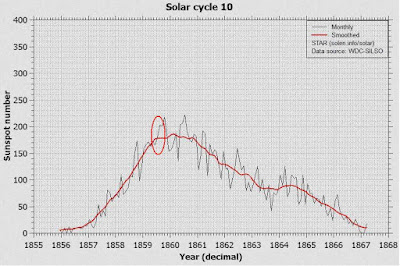 |
| courtesy: http://www.solen.info/solar/ |
Maybe I'd better stop wishing for flares.
 630m VK’s Light-Up North America
630m VK’s Light-Up North America
It seems that all of my blogspots of late have focused on 630m propagation ... but what has been happening down there recently has been both amazing and somewhat unexpected. With the growing number of active stations listening and transmitting, the band's propagation capabilities and mysteries are quickly revealing themselves.
Last night was a great example but perhaps the WSPRnet prop map illustrates this best.
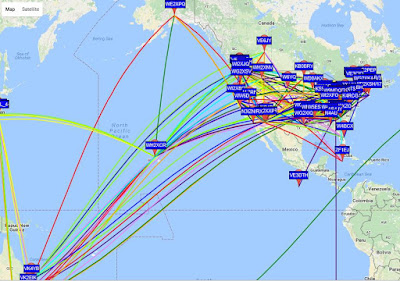 |
| courtesy: http://wsprnet.org/drupal/wsprnet/map |
Particularly striking was the long haul propagation from VK to North America, with northernmost VK4YB leading the pack. His 90 watt signal made it all the way to VE3IQB, near Ottawa as well as to NO3M, in Pennsylvania! To provide further hope to those that have little room for big receiving antennas, VE3IQB uses a typical small active e-probe antenna, 20' above ground!
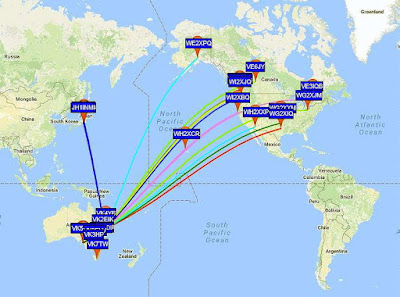 |
| courtesy: http://wsprnet.org/drupal/wsprnet/map |
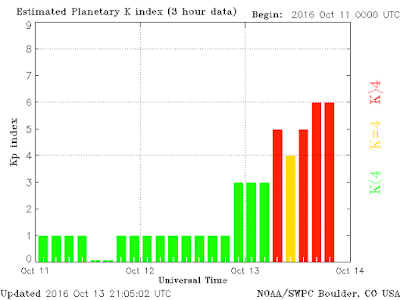 |
| courtesy: http://www.swpc.noaa.gov/ |
I'm theorizing that Roger's signal was arriving today at much lower angles than normal, evidenced by its far-reaching east coast reception and the fact that it couldn't get over my 600' local obstruction to the west. I've always believed that it takes higher angled signal arrival for me to hear Roger and today's events seem to support this.
Exactly what would cause this to be the case, I'll leave to the experts but I imagine that the sudden surge in geomagnetic activity played a significant role in today's very different propagation paths.
Roger was not the only VK lighting-up the map today. A much more detailed account of all the action can be found on the KB5NJD's daily 630m report here ... all very inspirational and hopefully enough to spur even more new activity on the MF band.
Why not give a listen and see what you can hear?
 CLE 211 Results
CLE 211 Results

This past weekend's CLE saw noticeably improved conditions compared with the previous event.
With the fall DX season fast-approaching, the combination of diminishing thunderstorm activity and improved propagation provided some interesting catches. Friday night was the best with Saturday having a brief period of favorable prop, while no new stations were heard on Sunday night, the poorest.
It was particularly nice to hear strong signals from the eastern provinces on Friday, highlighted with an excellent signal from 'JT' (390 kHz) in Stephenville, Newfoundland. This long haul east-west propagation can only be found with quite geomagnetic conditions as was the case on Friday.
After examining the geomagnetic 'K' data for Saturday (25th), it's interesting to note that the four catches for that night all coincided exactly with the brief green bar (K= 0-3) centered on the hours around 0900 UTC (circled).
The following NDBs were heard using my Perseus SDR and 'inverted-L' resonated to ~ 300kHz:
24 06:30 385.0 WL Williams Lake, BC, CAN
24 13:00 385.0 OCC Yakutat, ALS
24 10:00 385.0 MR Pacific Grove, CA, USA
24 13:00 385.0 EHM Cape Newenham, ALS
24 08:30 386.0 SYF St. Francis, KS, USA
24 06:30 386.0 HAU Helena, MT, USA
24 06:00 386.0 4N Oxford House, MB, CAN
24 06:30 388.0 MM Fort Mc Murray, AB, CAN
24 09:30 388.0 JW Pigeon, AB, CAN
24 06:30 388.0 GLY Clinton, MO, USA
24 06:30 389.0 YWB Kelowna, BC, CAN
24 08:00 389.0 TW Twin Falls, ID, USA
25 08:30 389.0 EN Kenosha, WI, USA
24 06:00 389.0 CSB Cambridge, NE,USA
24 06:30 390.0 JT Stephenville, NL, CAN
24 06:00 390.0 HBT Sand Point, ALS
24 06:00 390.0 AES Northway, ALS
24 06:30 391.0 TK Telkwa, BC, CAN
24 13:00 391.0 EEF Sisters Island, ALS
24 06:00 391.0 DDP Dorado, PTR
24 06:30 391.0 4W Kelsey, MB, CAN
24 08:30 392.0 ZFN Tulita, NT, CAN
24 06:00 392.0 PNA Wenz, WY, USA
24 06:30 392.0 ML Charlevoix, QC, CAN
25 08:30 392.0 FMZ Fairmont, NE, USA
25 08:30 392.0 BAJ Sterling, CO, USA
24 06:00 392.0 AGZ Wagner, SD, USA
25 09:30 393.0 TOG Togiak, ALS
24 08:30 393.0 2M Opapimiskan Lake,ON, CAN
24 13:00 394.0 RWO Kodiak, ALS
24 08:30 394.0 DQ Dawson Creek, BC, CAN
24 08:30 395.0 YL Lynn Lake, MB, CAN
24 06:00 395.0 ULS Ulysses, KS, USA
24 08:30 395.0 L7 Estevan, SK, CAN
24 08:30 396.0 YPH Inukjuak, QC, CAN
24 13:00 396.0 CMJ Ketchikan, ALS
24 08:30 397.0 ZSS Saskatoon, SK, CAN
24 08:00 397.0 SB San Bernardino, CA, USA
24 08:00 397.0 CIR Cairo, IL, USA
24 08:30 398.0 YOD Cold Lake, AB, CAN
24 08:30 398.0 3D Cumberland House, SK, CAN
24 08:30 399.0 ZHD Dryden, ON, CAN
24 13:00 399.0 SRI St George, ALS
The results from all participants can be found at the NDB List website, or if you are a member of the ndblist Group, results have also been e-mailed and posted there.
The very active Yahoo ndblist Group is a great place to learn more about the 'art' of NDB DXing or to meet other listeners in your region. There is a lot of helpful information available there and new members are always very welcome. As well, you can follow and chat with other NDB chasers regarding antennas, techniques, unidentified signals and nightly propagation.
 630m And Recent Geomagnetic Activity
630m And Recent Geomagnetic Activity

High levels of geomagnetic activity have usually, but not always, been the kiss-off-death for LF/MF propagation.
These past few months have seen fairly regular field disturbances, often pushing the K index to a level '5' or higher. However, while usually attenuating the east-west and northerly polar paths, the Trans-Pacific path often seems to benefit from these events ... particularly last night.
Perhaps it is related to the equinox's normal preference for this path or maybe the goop the sun is sending us at this point in the cycle is different or not as energetic as it is at mid-cycle. Nevertheless it's really encouraging to see that not all disturbances are detrimental to LF propagation.
For a daily summary of all overnight activity and much more, see KB5NJD's '630m Daily Reports'.
The WSPRnet map reproduced below shows the extent of reception during my own overnight WSPR 630m beaconing session. Missing are many of the normal spots from the eastern provinces and east coast states, indicating the attenuation on this path. Everything else seems enhanced.
 |
| courtesy: WSPRnet |
The path to down under, in-spite of my obstruction in that direction, perked-up as well, with VK4YB decoded here 19 times as well as VK3ELV's 150W and inverted-L near Wangaratta, Victoria.
13:56 VK4YB 0.4756 -28 QG62ku 11820
13:50 VK4YB 0.4756 -28 QG62ku 11820
13:44 VK4YB 0.4756 -24 QG62ku 11820
13:40 VK4YB 0.4756 -24 QG62ku 11820
13:30 VK4YB 0.4756 -27 QG62ku 11820
13:24 VK4YB 0.4756 -20 QG62ku 11820
13:18 VK4YB 0.4756 -24 QG62ku 11820
13:12 VK4YB 0.4756 -22 QG62ku 11820
12:42 VK4YB 0.4756 -26 QG62ku 11820
12:14 VK4YB 0.4756 -20 QG62ku 11820
12:02 VK4YB 0.4756 -23 QG62ku 11820
11:58 VK4YB 0.4756 -25 QG62ku 11820
11:52 VK4YB 0.4756 -25 QG62ku 11820
11:40 VK4YB 0.4756 -29 QG62ku 11820
11:32 VK4YB 0.4756 -26 QG62ku 11820
11:24 VK4YB 0.4756 -25 QG62ku 11820
11:12 VK4YB 0.4756 -22 QG62ku 11820
10:56 VK4YB 0.4756 -26 QG62ku 11820
10:54 VK4YB 0.4756 -25 QG62ku 11820
Merv, WH2XCR in Hawaii, was spotted here 56 times, with numerous transmissions at 'easy CW' levels. He even spotted me twice, with his 80m dipole, presently laying on the ground!
It was also encouraging to see 21 spots from Eden, ZF1EJ in the Cayman Islands, with several at CW levels.
The following stations all uploaded spots of my overnight WSPR signals, as nightly activity continues to grow with the DX season now at the doorstep. Given equal ERP, most of these stations would be workable on either CW or on JT9.
WH2XGP DN07dg 319 122
WG2XSV CN85sr 353 169
WI2XJQ CN87ts 138 150
NO1D DM34tn 1825 147
N3IZN/RX DM13ji 1796 161
WW6D CM88pl 1155 177
VE7CNF CN89ng 55 33
VA7MM CN89og 59 38
WE2XPQ BP51ip 2151 321
W5EMC EM10cl 2963 124
K5ACL EM10bd 2987 125
WG2XXM EM15lj 2610 115
ZF1EJ/1 EK99ig 4977 116
KE7LGT DN26xm 739 107
W3PM EM64or 3365 104
ZF1EJ EK99ig 4977 116
VE7KPB DN29cm 550 79
KU7Z DN41af 1227 129
WH2XCR BL11je 4295 236
KB0BRY EN17nc 1966 86
WD2XSH/20 CN83 598 178
WG2XIQ EM12 2841 120
WE4X EM65ut 3326 102
VE7BDQ CN89la 26 44
KB7W CN93jx 565 163
W6LEO DN17oq 498 103
WH2XAR DM33vp 1924 147
As interest in 630m continues to expand, many U.S. amateurs are already building their stations so they will be ready to go when the word finally comes. I suspect that 630m may soon sound like a small slice of 40m on a busy night ... will you be ready?
 Magicband Morphs
Magicband Morphs
I have been having fun on 6m every summer since the late 60's. Without doubt, this summer's Sporadic-E (Es) season is the worst one I have experienced in terms of domestic (North America) openings. This summer was almost a carbon-copy of last year's summer Es season. As I mentioned in an earlier blog, unless this is some form of short term or cyclical anomaly, the fundamental nature of Sporadic-E openings appears to be undergoing some type of change. Missing-in-action were the numerous day-long intense openings to California as well as the grand openings to the eastern states (FN grids) and Canada ... all guaranteed openings every summer. These openings would often last well into the late night hours and even overnight, picking up the next day where they left off. This is the second summer in a row where no Es MUF's into the 2m band were experienced, with this year having seen nothing even as high as the 88-108MHz FM band. Maybe I missed them if they occurred, but I don't think so.
In terms of non-domestic openings, the band continues to evolve, as it seems that a higher percentage of hours with very long skip continues to rise. As poor as this year has been domestically, CW contacts were completed with Germany, Ireland, England, Japan, France, Canary Islands, Balearic Island, Venezuela, Cuba, Puerto Rico, and the Cayman Islands. A short and exceptionally rare opening to Africa, allowed an 'almost QSO' with CN8KD in Morocco, as he had one letter of my call incorrect when he quickly faded away ... pretty exciting even for a 'busted' QSO on 6m, in the middle of summer. Whether this very long propagation is just multi-hop traditional Es or something entirely different is still up for debate, as often there are no indicators (beacons or other mid-point signals) indicating that the band is even open. Many, including myself, believe this is some form of chordal hop or interlayer ducting, involving the E-layer alone or perhaps even the bottom of the F layer. Signals strengths can reach 599 levels and almost without fail, have extremely small footprints, with stations just a few miles away hearing nothing at all.
When these openings occur between western North America and Europe, they can be very exciting, as the footprint on the European end often sprays around like a stray garden hose, popping up in a different country with each passing minute. Openings are often fast and furious and always heart-pounding! Perhaps there is still some magic yet to occur but the 'normal' season (or what used to be normal) is drawing to a close as August nears. The fat-lady is warming up her voice behind the curtain and will soon be singing once again. But something else is changing on 6m besides the propagation and that is the huge growth of the JT65 weak signal digital mode. As the season draws slowly down, I still see long-time dedicated CW operators going up the band to dip their toes for the first time on this alternate mode. I have used it fairly often to work stations when the CW / SSB end of the band appears to be dead. The maps shown below, grabbed just four days ago, illustrate what I have been seeing. The amount of JT65 activity is striking, compared to the traditional CW/SSB modes, both shown for the same one hour period. I could assume that the several extra db of weak-signal sensitivity is the reason for the disparity seen from one mode to the other but there may be other factors coming into play.
Once the band really opens however, the weak-signal sensitivity of JT65 soon looses its previous advantage and the JT65 segment of the band can get pretty clobbered, with numerous signals on top of each other, all competing for their ~200Hz slice of the spectrum. As well, a JT65 QSO is slow ... a minimum of four minutes. Taking four minutes to exchange calls, reports and 'rogers' on a wide open band with strong signals, makes little sense. Perhaps the majority of 6m JT65 operators are new amateurs with a codeless licence or are operating in antenna-restricted communities. Whatever the reason, the numbers are growing and traditional operating patterns are changing. Who knows what next summer will bring!
 |
| Chordal Hop courtesy: http://g4fkh.co.uk/projects/lp-experiment/ |
 |
| Inter Layer Ducting courtesy: http://g4fkh.co.uk/projects/lp-experiment/ |
 |
| courtesy: http://www.dxmaps.com/ |
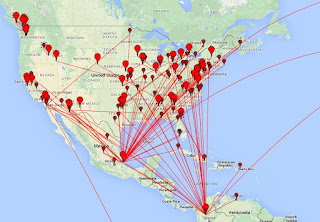 |
| courtesy: https://pskreporter.info/pskmap.html |
 April’s Single-Yagi EME
April’s Single-Yagi EME
With several QSL's from last month's EME action now arriving, April's 'best days' have just concluded. For me, operating with no antenna elevation, 'best days' mean those with northern-most lunar declinations (these put the moon rising clearly and almost directly out in front of the house, not in the neighbour's trees); not having the moon near the sun and also, having the moon closer to perigee (closest approach to earth) rather than apogee (furthest from earth). With just a single 9 element yagi, every db is precious.
A website that helps determine when these good days occur, is the Making More Miles On VHF eme page. A graphical display of several important elements will easily determine which days might be best to operate ...
... but I have also found success on days that don't look particularly great, with the moon approaching apogee and it's subsequent higher db path loss. As with most radio propagation, there is also some magic involved and, just like on any band, some days are simply 'better' and for no obvious reason.
This month saw six EME contacts, some with stations worked previously, in 2007, and not 'new uniques', while three were new, bringing my uniques total to 73, with this small, horizon-gain assisted system.
G4SXW John 4 x 16el array #71 ... answered my CQ
KB8RQ Gary 24 X 13el array!! worked with moon at 1 deg high
UX5UL Oleg 4 x 16el array #72
UT6UG Val 4 x 32el array #73 Val and Oleg both live in Kyiv, Ukraine
RK3FG Anatoly 4 X 15el array
K9MRI Joe 8 X 28el array - Indiana
As summer approaches, it will be interesting to see how favorable the above mentioned variables will come into play as many of the best northerly declination days will also closely follow the sun and its increased background skynoise ... not so much a problem for me but for those bigger stations trying to hear a very weak signal in a noisier sky.
A website that helps determine when these good days occur, is the Making More Miles On VHF eme page. A graphical display of several important elements will easily determine which days might be best to operate ...
 |
| courtesy: http://www.mmmonvhf.de/eme.php |
This month saw six EME contacts, some with stations worked previously, in 2007, and not 'new uniques', while three were new, bringing my uniques total to 73, with this small, horizon-gain assisted system.
G4SXW John 4 x 16el array #71 ... answered my CQ
KB8RQ Gary 24 X 13el array!! worked with moon at 1 deg high
UX5UL Oleg 4 x 16el array #72
UT6UG Val 4 x 32el array #73 Val and Oleg both live in Kyiv, Ukraine
RK3FG Anatoly 4 X 15el array
K9MRI Joe 8 X 28el array - Indiana
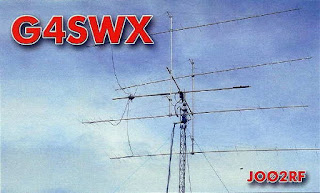 |
| G4SWX 4 x 16 el EME Array |
 |
| KB8RQ 24 x 13 el EME Array |
As summer approaches, it will be interesting to see how favorable the above mentioned variables will come into play as many of the best northerly declination days will also closely follow the sun and its increased background skynoise ... not so much a problem for me but for those bigger stations trying to hear a very weak signal in a noisier sky.



